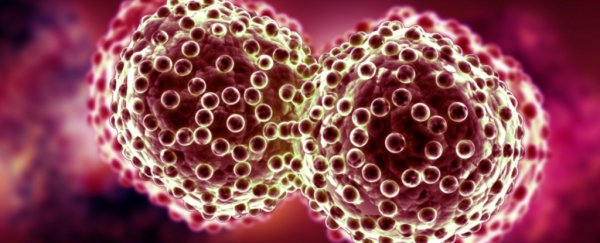Cancer treatments are often brutal and painful. The most common form, chemotherapy, aims to kill tumours by targeting fast-growing cells throughout the body, usually killing healthy cells in the process.
Now, those days may soon come to an end because researchers in Canada have created a type of shape-shifting nanoparticle that can pinpoint tumours and deliver chemotherapy drugs directly to them without affecting the rest of the body.
The team, led by Warren Chan from the University of Toronto, has worked for over a decade trying to come up with a way to have cancer drugs fight only malignant tumours, a task that is way easier said than done.
Normally, these drugs are administered through the bloodstream, which spreads them all over the body, killing healthy cells in their path. Not only is this not as effective as targeted approaches, these treatments cause a slew of horrible side effects like stomach pain, nausea and hair loss, because these areas typically have fast-growing cells that, to the drugs, look a lot like cancer.
After studying how normal treatments work and how certain DNA signatures can provide markers for cancer, Chan and his team came up with a shape-shifting nanoparticle that is made of metal with DNA strands fixed to them. These nanoparticles will float through the bloodstream and bind to cancer cells where they will change shape and deliver whatever drug or signalling marker the physician desires.
So why does it have to shape-shift?
According to Chan, "Your body is basically a series of compartments. Think of it as a giant house with rooms inside. We're trying to figure out how to get something that's outside, into one specific room. One has to develop a map and a system that can move through the house where each path to the final room may have different restrictions such as height and width."
Having the ability to change shape allows the particles to flow freely to any area of the body. The DNA strands attached to the particles enable them to seek out different types of cancer because every tumour is slightly different and, therefore, hard to track down, which is why traditional chemotherapy has likely remained the go-to treatment for years.
"Here's how we look at these problems: it's like you're going to Vancouver from Toronto, but no one tells you how to get there, no one gives you a map, or a plane ticket, or a car - that's where we are in this field," said Chan. "The idea of targeting drugs to tumours is like figuring out how to go to Vancouver. It's a simple concept, but to get there isn't simple if not enough information is provided."
"We've only scratched the surface of how nanotechnology 'delivery' works in the body, so now we're continuing to explore different details of why and how tumours and other organs allow or block certain things from getting in," he added.
There is still a lot of research to do before nanoparticles see true use in hospitals around the globe. But finding a cancer treatment that can specifically target tumours is a big step forward.
You can read the team's full report in Proceedings of the National Academy of Sciences.
